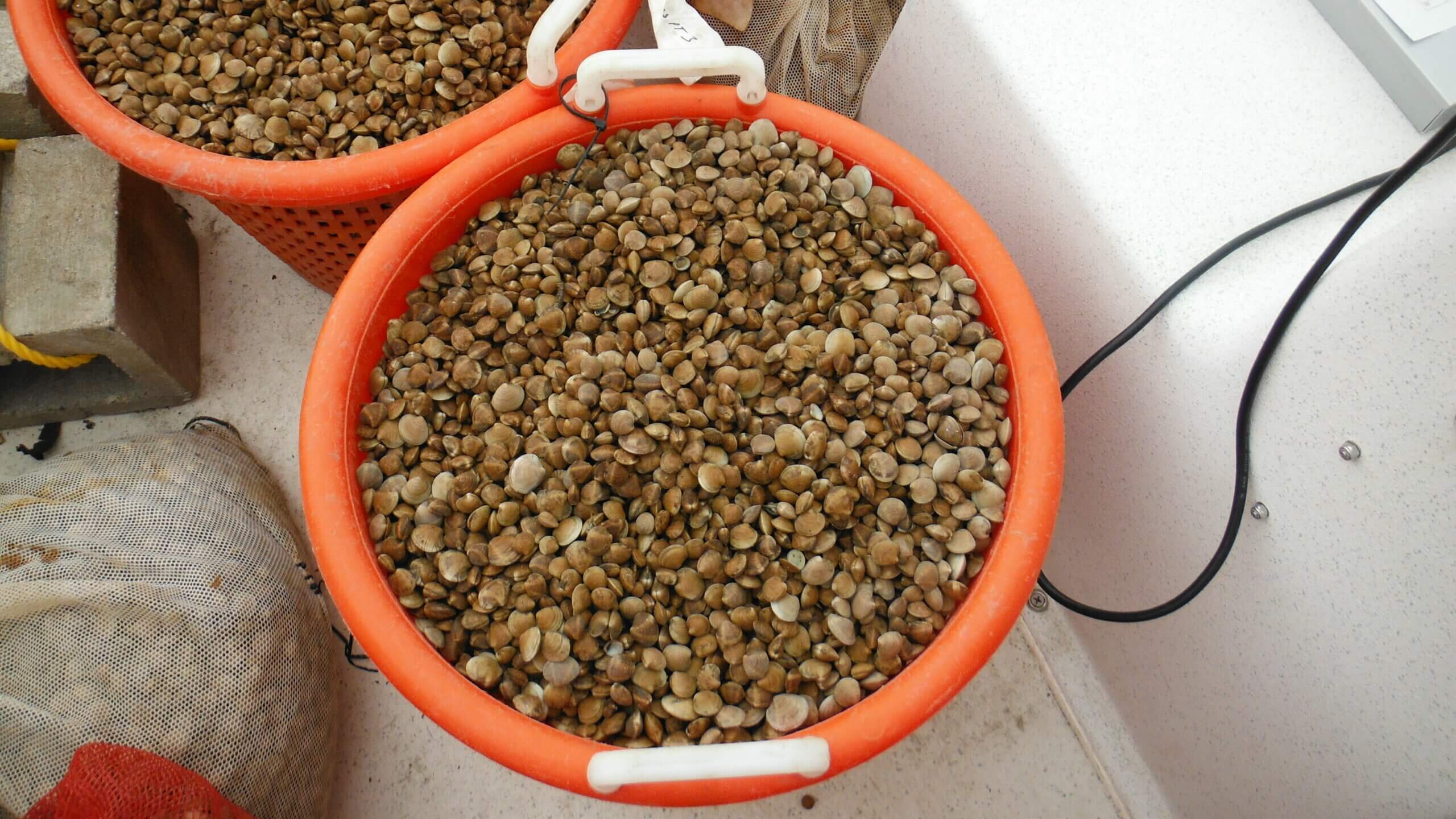Shellfish enhancement involves the placement of shellfish seed in designated areas throughout the Atlantic coastal estuaries to help bolster population numbers. “Seed” is the term used to describe small, juvenile shellfish. The State generally purchases seed that is around 18mm-25mm (0.71-0.98 in.) in size. Hard clams (Mercenaria mercenaria) are the primary species purchased and planted. Barnegat Bay has been the main target of enhancement activities, with a particular focus on planting within the Sedge Island Marine Conservation Zone. Bay scallop (Argopecten irradians) seed has also been purchased when available.
Enhancement activities began in 2006 and have continued on a regular basis ever since, based on the availability of seed. As of 2020, the State has planted an estimated 7.4 million hard clam seed and approximately 65,000 bay scallop seed. Although the Barnegat Bay SIMCZ has received the most enhancement to date, clam seed has also been planted in the Navesink River, Little Egg Harbor, Great Bay, and other parts of Barnegat Bay. Additional areas are planned for other parts of the Barnegat Bay complex as well as estuaries from Monmouth to Cape May counties.

Species/Habitat of Interest
Hard clam (Mercenaria mercenaria)
Hard clams survive in a wide range of water quality and sediment characteristics. Adults have an optimal temperature range of about 20-30°C (68-86°F) for growth and reproduction, but can survive temperatures ranging 0-35°C (32-95°F). Feeding activity and growth are curtailed at the extremes of the range, sometimes resulting in death after extended periods of exposure to temperature extremes. Hard clams prefer a salinity range of 20-35 ppt, with mortality occurring at <12-17ppt. Clams are very tolerant of low dissolved oxygen levels (as low as 0.5mg/L) but are stressed at levels <5.0mg/L. Egg and larval stages have narrower temperature and salinity tolerances than adults. Both juvenile and adult stages are sensitive to pH values outside of 7.0-8.75.
Hard clams are an infaunal species, burrowing into substrates by as much as 8 inches, but typically staying within the top 4 inches. They are found in sand, mud, and shell substrates (or any combination thereof) but grow fastest in sandy sediments and slowest in muds. Areas with shell often provide some protection from predators, especially at juvenile stages.
Bay scallop (Argopecten irradians)
Bay scallops are a short-lived estuarine species, living 1-2 years and usually dying in their second winter. They are found in salinities and temperatures similar to those of hard clams. Bay scallops are hermaphroditic, meaning they possess male and female gametes (reproductive cells). They typically spawn only once in their lives, and water temperatures of around 18°C (65°F) trigger a spawning event.
Bay scallops are an epifaunal species, meaning they live on top of or very near the bay bottom, and do not burrow into the sediment the way clams do. Instead, they prefer shallow sand and mud flats, and especially seagrass beds. As juveniles, bay scallops settle out of the water column and attach to seagrasses for protection from predators, until they mature and settle out to the bay bottom. Seagrasses are also important for predator protection at this stage, making seagrasses a critical habitat for this species.
Bay scallops are unique from other bivalve species in that they can “swim” short distances in the water column by opening and closing their valves to create propulsion.
Methods
Site Selection
Proper site selection for shellfish enhancement activities is critical to achieve the greatest likelihood of success. The Bureau looks at a variety of environmental factors to determine the appropriate locations to plant shellfish. Water quality, substrate type, predation concerns, and historical shellfish productivity are among some of the factors evaluated when determining the optimal planting location. The biological and habitat needs of each species are compared with the environmental conditions of different sites to determine the most appropriate locations that will promote growth and survivorship.
Seed Acquisition
Seed is purchased from shellfish hatcheries and collected by staff. A subsample of the total volume of seed is counted and measured to estimate the number of seed planted.
Vessel(s) and Gear or Equipment Used
Bags or bushels of seed are loaded onto state research vessels where they are shuttled out to the in-water planting site. Buoys are temporarily placed at the corners of each plot that is planted to reference the planting site boundaries. Staff “plant” the seed by gently tossing the shellfish into the water by hand as the boat travels throughout the plot to distribute it as evenly as possible. If the water is too shallow, staff will walk transects in the water. Hard clam seed then burrows into the substrate to live out the remainder of its life. Bay scallops are epibenthic, meaning they live above the substrate, and as juveniles prefer to attach to seagrasses for predation protection.


Season(s) or Frequency of Sampling
Seed is usually planted in the early spring or late fall, as excess seed from hatcheries may become available and water temperatures are above 50°F. The spring and fall are best for planting as predators of small seed are at lower levels providing the shellfish seed a better chance to grow and survive. Staff attempt to plant hard clam on an annual basis.
Project Lead Contact Information/Designated Contact Person
Scott Stueber, Senior Fisheries Biologist
Scott.Stueber@dep.nj.gov
 Official Site of The State of New Jersey
Official Site of The State of New Jersey

